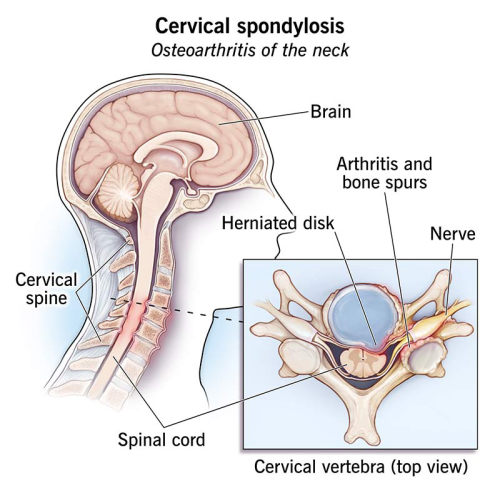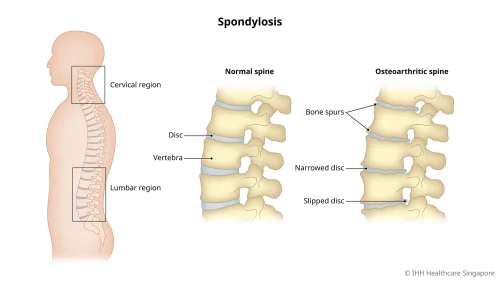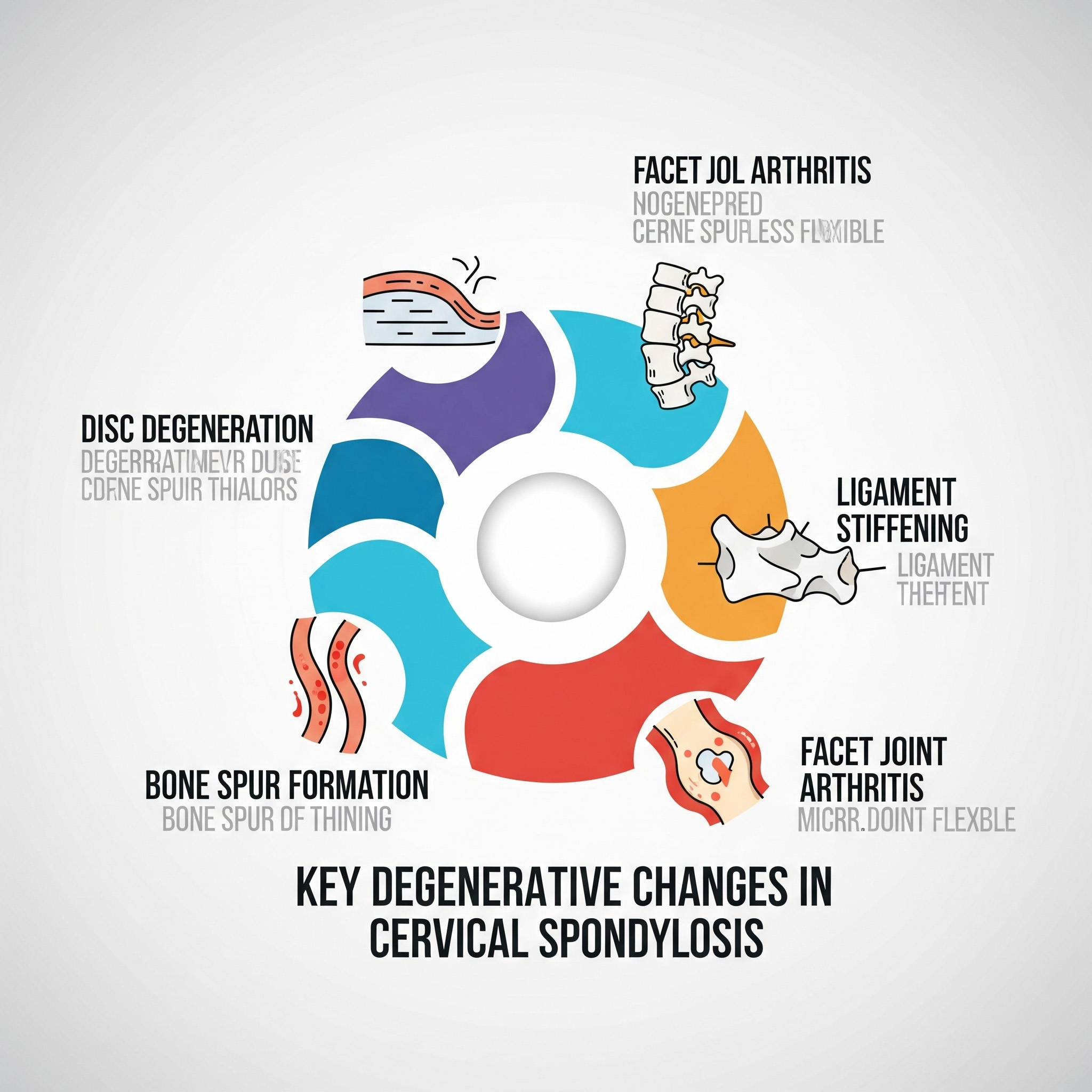Stress & Sleep Disorders
August 5, 2025Herbal Medicines
August 6, 2025Cervical Spondylosis
Cervical Spondylosis – Ayurvedic Insight & Holistic Healing
Are you constantly bothered by nagging neck pain, stiffness in the shoulders, or that annoying feeling of dizziness and imbalance? These could be more than just signs of fatigue or poor posture — you may be suffering from Cervical Spondylosis, a progressive degenerative condition of the neck vertebrae that can significantly disrupt your daily life, sleep, and overall well-being.Cervical Spondylosis, also known as cervical osteoarthritis, primarily affects people over the age of 40, but today, due to sedentary lifestyles, long hours of screen time, and poor posture, it is increasingly being seen in younger individuals as well. This condition involves the gradual wear and tear of the bones, joints, and discs in the cervical spine (neck region), leading to pain, stiffness, nerve compression, vertigo, and in severe cases, even neurological symptoms like numbness, tingling, and weakness in the arms and hands.
 At Dr. Nischal Sharma’s Panchakarma & Ayurveda Centre, located on Bhakra Dam Road, Nangal, we offer a holistic and natural approach to managing Cervical Spondylosis through the ancient wisdom of Ayurveda. Unlike conventional treatments that often rely on painkillers and temporary relief, our Ayurvedic treatments focus on treating the root cause, balancing the body’s doshas (especially aggravated Vata), and restoring the natural strength, flexibility, and functionality of the cervical spine.Using personalized Panchakarma therapies, medicated herbal formulations, and a carefully curated diet and lifestyle regimen, we help our patients experience long-term relief from neck pain, improve posture, and prevent further degeneration. Whether you’re struggling with occasional neck stiffness or have been diagnosed with a chronic condition, our centre provides authentic, doctor-supervised Ayurvedic care tailored specifically to your needs.Experience the power of traditional healing with modern comfort. Regain control over your body, reduce your dependency on pain medications, and embrace a life of pain-free movement with our natural, non-invasive treatments for Cervical Spondylosis. Join the hundreds of patients from Nangal and surrounding areas who have found relief, rejuvenation, and renewed energy through Ayurveda at our centre.
At Dr. Nischal Sharma’s Panchakarma & Ayurveda Centre, located on Bhakra Dam Road, Nangal, we offer a holistic and natural approach to managing Cervical Spondylosis through the ancient wisdom of Ayurveda. Unlike conventional treatments that often rely on painkillers and temporary relief, our Ayurvedic treatments focus on treating the root cause, balancing the body’s doshas (especially aggravated Vata), and restoring the natural strength, flexibility, and functionality of the cervical spine.Using personalized Panchakarma therapies, medicated herbal formulations, and a carefully curated diet and lifestyle regimen, we help our patients experience long-term relief from neck pain, improve posture, and prevent further degeneration. Whether you’re struggling with occasional neck stiffness or have been diagnosed with a chronic condition, our centre provides authentic, doctor-supervised Ayurvedic care tailored specifically to your needs.Experience the power of traditional healing with modern comfort. Regain control over your body, reduce your dependency on pain medications, and embrace a life of pain-free movement with our natural, non-invasive treatments for Cervical Spondylosis. Join the hundreds of patients from Nangal and surrounding areas who have found relief, rejuvenation, and renewed energy through Ayurveda at our centre.
What is Cervical Spondylosis?

Cervical Spondylosis is a degenerative condition of the cervical spine — the portion of the backbone located in the neck. Also referred to as cervical osteoarthritis, it primarily affects the vertebral bones, intervertebral discs, ligaments, and joints of the neck. This condition is usually age-related but can also be triggered by lifestyle factors, poor posture, or repetitive strain on the neck muscles.
As a person ages, the structures in the cervical spine gradually undergo wear and tear. The intervertebral discs, which act as cushions between the vertebrae, begin to dry out and shrink. This can lead to disc thinning, reduced flexibility, and the development of bony outgrowths known as bone spurs (osteophytes). These changes can cause compression of nearby spinal nerves or even the spinal cord, resulting in pain and neurological symptoms.
Cervical Spondylosis is incredibly common and affects more than 85% of people over the age of 60, though symptoms can begin much earlier, especially in individuals with sedentary lifestyles, poor ergonomics, or repetitive neck movements. Modern-day factors like extended computer usage, mobile phone overuse, and lack of physical activity have contributed to a sharp rise in cases among younger adults as well.
How Cervical Spondylosis Develops
The condition typically develops gradually over time and may initially be silent (asymptomatic). As the degeneration progresses, individuals may begin to experience a range of symptoms due to the narrowing of the spinal canal (cervical spinal stenosis) or nerve root compression (cervical radiculopathy).
Why You Shouldn’t Ignore It
While some people may experience only mild discomfort or stiffness, others might face chronic neck pain, radiating pain into the shoulders and arms, muscle weakness, tingling or numbness in the fingers, and episodes of dizziness or vertigo due to compromised blood flow or nerve involvement. In severe cases, spinal cord compression can cause loss of coordination, difficulty in walking, and bladder or bowel issues, which require immediate medical attention.
Key Degenerative Changes in Cervical Spondylosis:
-
Disc Degeneration: The intervertebral discs lose hydration and elasticity, leading to reduced shock absorption.
-
Bone Spur Formation: The body produces bony growths in an attempt to stabilize the spine, which may press on nerves or the spinal cord.
-
Ligament Stiffening: Ligaments may thicken or stiffen over time, reducing neck flexibility.
-
Facet Joint Arthritis: The joints that connect the vertebrae become inflamed and worn out, contributing to pain and restricted movement.

Common Symptoms of Cervical Spondylosis
Cervical Spondylosis is a condition that often develops silently over time, but as it progresses, it can present with a variety of distressing symptoms. These symptoms are not just limited to the neck region — they can also radiate to other parts of the body due to nerve compression or impaired circulation. Recognizing the signs early is crucial for timely intervention and preventing further complications.
Below are the most commonly experienced symptoms of Cervical Spondylosis:
1. Persistent Neck Pain and Stiffness
The most frequent and earliest symptom is a dull, aching pain in the neck, often accompanied by stiffness. The pain may worsen after long periods of sitting, standing, or working on a computer, and typically feels better with rest or mild movement. Many individuals describe a “tight” or “tense” feeling in the neck and upper shoulders, particularly in the morning or late evening. Stiffness may limit the ability to turn or tilt the head, making simple activities like driving or looking over the shoulder uncomfortable.
2. Headaches (Occipital Headaches)
Headaches, especially those originating from the back of the head (occipital region), are another common symptom. These headaches are typically caused by tension in the neck muscles or irritation of the nerves exiting the cervical spine. The pain may radiate toward the forehead, temples, or behind the eyes and is often accompanied by a heavy or throbbing sensation. Such headaches can be persistent and may be misdiagnosed as migraines or tension headaches.
3. Radiating Pain to the Shoulders and Arms
In more advanced cases, cervical spondylosis can lead to compression or irritation of the nerve roots that exit the spinal cord and travel to the arms. This can cause a sharp, shooting, or burning pain that travels from the neck down to the shoulders, upper arms, forearms, and even into the hands and fingers. This condition is medically known as cervical radiculopathy. The pain often worsens with neck movement, coughing, or sneezing.
4. Tingling or Numbness in Hands and Fingers
When nerves are compressed due to bone spurs or herniated discs in the cervical spine, sensory symptoms such as tingling (pins and needles) or numbness may occur in the arms, hands, and fingers. This can affect grip strength, fine motor skills, and make everyday tasks — like writing, holding utensils, or buttoning a shirt — more difficult. In severe cases, the loss of sensation may become constant and interfere with hand coordination.
5. Giddiness or Vertigo
Some individuals with Cervical Spondylosis experience dizziness, light-headedness, or episodes of vertigo. These symptoms may be caused by compromised blood flow to the brainstem due to vertebral artery compression or tension in the neck muscles affecting balance. Vertigo episodes may be triggered by sudden neck movements or changes in posture, and can sometimes be accompanied by nausea or visual disturbances.
6. Muscle Weakness
Muscle weakness is a sign that the nerve signals are being disrupted due to nerve root or spinal cord compression. Patients may feel weakness in the shoulders, arms, or hands, making it difficult to lift objects, perform overhead activities, or maintain grip strength. This can lead to frequent dropping of objects or difficulty in lifting daily-use items.
7. Loss of Balance and Coordination
In more severe or long-standing cases of Cervical Spondylosis — particularly when the spinal cord is affected (a condition known as cervical myelopathy) — patients may begin to experience problems with balance, coordination, and gait. They may find it harder to walk steadily, climb stairs, or perform precise leg movements. In extreme cases, this may also lead to urinary or bowel disturbances, signaling serious spinal cord involvement that needs immediate attention.

